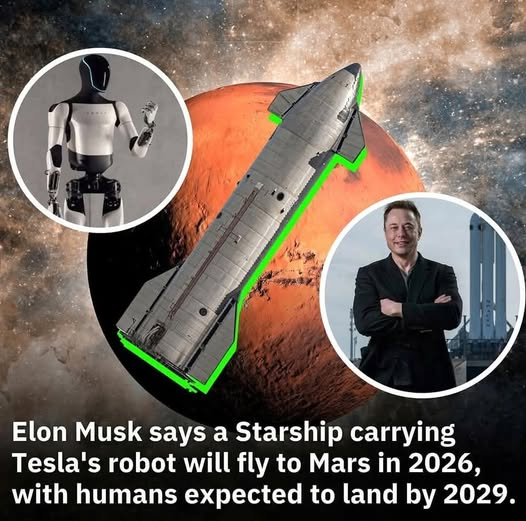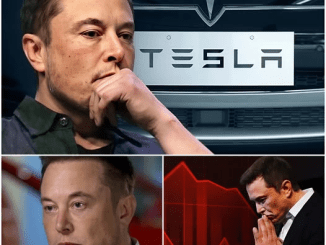
SpaceX’s ambitious Mars colonization plan is one step closer to reality. Elon Musk, the visionary entrepreneur behind Tesla and SpaceX, has announced that the company’s massive Starship rocket is set to embark on its first voyage to Mars in late 2026. This historic mission will also include Tesla’s humanoid robot, Optimus, marking a significant step toward automating tasks on the Red Planet.
If all goes according to plan, Musk envisions human landings on Mars as early as 2029, though 2031 remains the more realistic target. The Starship rocket, towering at 123 meters (403 feet), holds the title of the largest and most powerful rocket ever built and is designed for full reusability.
With the inclusion of Optimus, SpaceX aims to revolutionize not only space exploration but also daily life on Earth, as Tesla’s humanoid robot is expected to play a vital role in space missions and industrial applications.
🚀 Starship: The Rocket That Will Take Humanity to Mars
Starship is a two-stage, fully reusable rocket system, consisting of:
✅ Super Heavy Booster – The lower stage, providing massive thrust for takeoff.
✅ Starship Upper Stage – The spacecraft that will carry cargo, robots, and eventually humans to Mars.
SpaceX has been developing Starship with rapid iteration at its Boca Chica, Texas facility, conducting several high-altitude and orbital test flights. Musk envisions thousands of Starships launching regularly, making interplanetary travel cost-effective and sustainable.
🔥 Why is Starship Revolutionary?
🔹 Full Reusability – Designed to be launched, landed, and relaunched, reducing costs significantly.
🔹 Largest Payload Capacity – Capable of carrying over 100 tons of cargo to Mars.
🔹 Multi-Purpose Design – Can be used for Moon missions, space stations, asteroid mining, and even Earth-to-Earth travel.
Starship’s first Mars mission in 2026 will serve as a crucial test for future human settlements, laying the groundwork for infrastructure and robotic assistance.
🤖 Tesla’s Optimus: The Humanoid Robot That Will Pave the Way on Mars
In a surprising twist, Tesla’s humanoid robot, Optimus, will be onboard the mission, helping SpaceX prepare for human arrival. Optimus, priced between $20,000 and $30,000, has been in development since 2021 and is expected to revolutionize labor and automation.
🚀 What Will Optimus Do on Mars?
🛠 Assist in Construction – Optimus can assemble habitats, solar panels, and infrastructure before humans arrive.
📡 Perform Maintenance – The robot will repair equipment and monitor systems in the harsh Martian environment.
🌱 Support Agriculture – Optimus may assist in growing food in enclosed habitats, a key step in long-term survival.
🚚 Transport Materials – With its advanced AI and mobility, Optimus can carry supplies and tools across Mars’ rugged terrain.
By integrating Tesla’s AI-driven technology, SpaceX ensures that humans won’t have to do all the heavy lifting upon arrival. Instead, Optimus will prepare Mars for human habitation, accelerating Musk’s goal of creating a self-sustaining civilization on the Red Planet.
🌍 From Earth to Mars: The Roadmap to Colonization
Musk has long stated that making humanity a multi-planetary species is his ultimate mission. He believes that relying solely on Earth is too risky, given potential threats like climate change, asteroid impacts, and resource depletion.
🛸 Timeline for Mars Exploration
🔹 2026 – First Starship mission with Optimus robots and cargo.
🔹 2029 – Potential first human landing on Mars.
🔹 2031-2040 – Construction of permanent bases and small colonies.
🔹 2050 – Musk’s goal of a one-million-person Mars colony begins to take shape.
While these targets are incredibly ambitious, SpaceX’s rapid progress with Starship testing, refueling technology, and AI automation suggests that Musk’s timeline may not be far-fetched.
💡 The Impact of Optimus and Starship on Earth
Beyond Mars, both Starship and Optimus will have profound implications on Earth’s industries:
🌍 Earth-to-Earth Space Travel – Starship could enable 90-minute global flights, making long-distance travel as fast as a domestic flight.
🏭 Industrial Automation – Optimus could revolutionize factories, warehouses, and dangerous jobs, reducing human labor risks.
🚀 Space Economy – A fully operational Mars settlement could lead to industries like asteroid mining, interplanetary tourism, and new space markets.
Musk’s vision for the future is no longer science fiction—it’s rapidly becoming engineering reality.
🛸 Conclusion: The Future is Closer Than We Think
With Starship launching in 2026 and Optimus joining the mission, humanity is taking its first real steps toward interplanetary living.
Elon Musk’s bold vision is pushing the boundaries of what’s possible, proving that with innovation, AI, and relentless ambition, even the Red Planet is within reach.
As we move closer to the first human colony on Mars, one thing is certain:
🚀 The future of space exploration is happening now.


